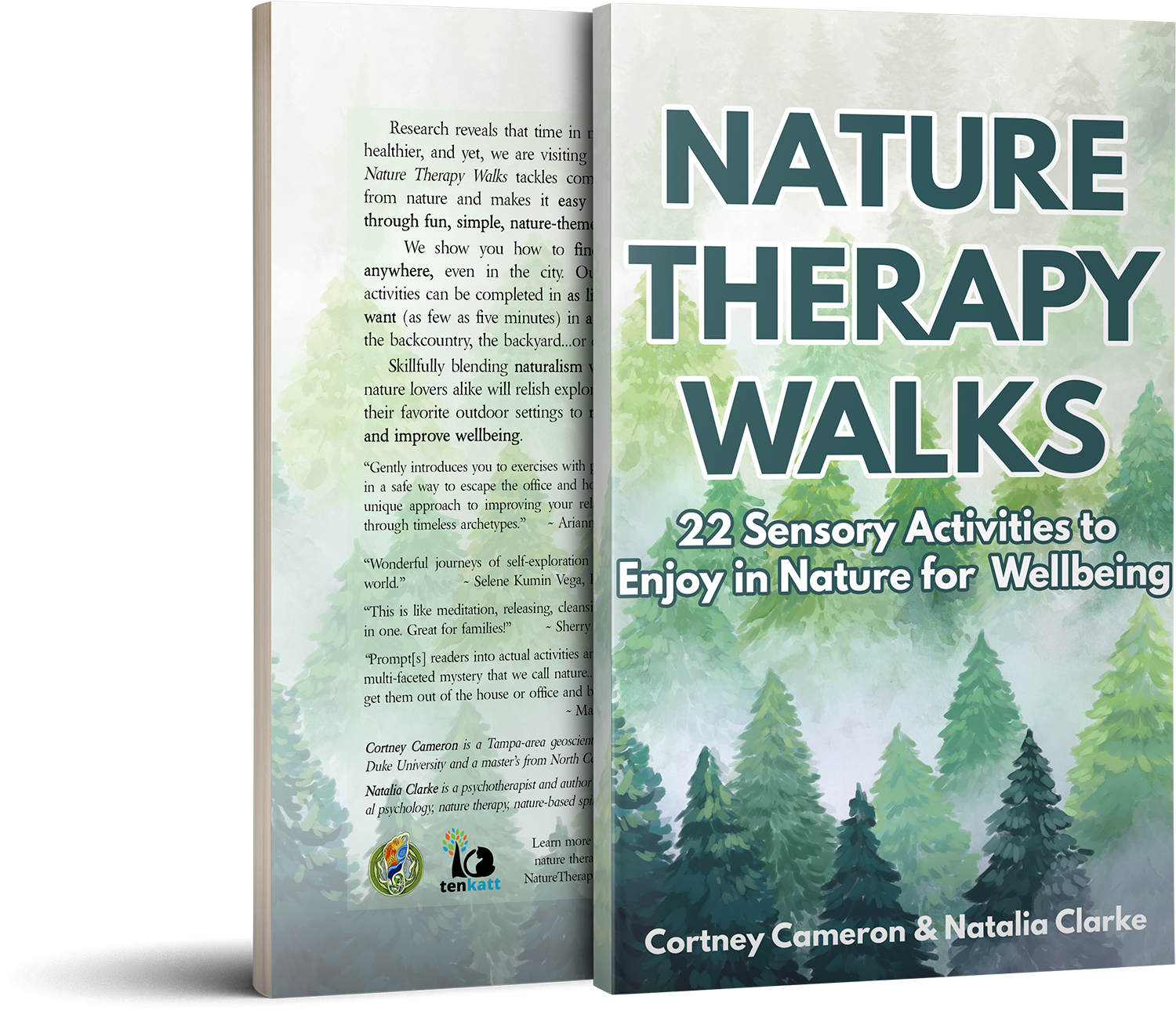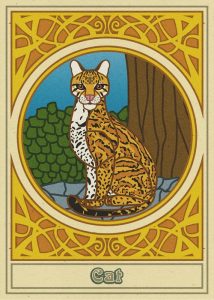
Spending time in nature makes people happier and healthier!
Research reveals that time in nature makes us happier and healthier, and yet, we are visiting nature less than ever before. Nature Therapy Walks tackles common reasons we dissociate from nature and makes it easy to reconnect and revitalize through fun, simple, nature-themed activities and meditations. We show you how to find and engage with nature anywhere, even in the city. Our flexible and experiential activities can be completed in as little or as much time as you want (as few as five minutes) in a variety of settings, whether the backcountry, the backyard…or even indoors! Skillfully blending naturalism with spirituality, science and nature lovers alike will relish exploring these guided activities in their favorite outdoor settings to reinforce their nature bonds and improve wellbeing.
NEW! Learn to lead others in nature. Become a Certified Nature Therapy Guide in partnership with the Natural Wellness Academy! Learn more.
How it Works
Nature Therapy as easy as 1-2-3!
① Select a guided activity. To employ chance, use the Number Board on page 7, randomly flip to a page, or draw a card. Alternatively, you may simply choose the activity that seems most attractive on that day.
② Complete the activity, ideally in a wild or semi-wild natural place. However, a bit of vegetation or other natural features will suffice. You can also perform a pure visualization (a nature photo is helpful for this). Spend a few minutes or a few hours—whatever works for you.
③ Keep an open mind and enjoy yourself!
Gallery
Click through the table of contents and image gallery below to preview the activities in the book.
Table of Contents
- Nature Therapy
- How to Use This Book
- Number Board
- Activities
- Dragonfly (Sun) – Basking
- Moth (Moon) – Reflections
- Cat – Crossing the Threshold
- Raccoon – Wild Dance
- Tree – Tree Hugging
- River – Dowsing
- Mountains – Earthing
- Tortoise – Fairy Houses
- Spider – Web-Building
- Squirrel – Taking Stock
- Wolf – Accounting
- Opossum – Personal Runes
- Crane – Sky Gazing
- Hawk – Change of View
- Owl – Through Your Eyes
- Snake – Hide-and-Seek
- Raven – Planting a Seed
- Salamander – Light and Shadow
- Bee – Forest as Community
- Bear – Seasonal Celebration
- Firefly (Star) – Star Fields
- The World – Elemental Bathing
Reviews
“These experiences you have guided readers through are wonderful journeys of self-exploration and connection with the natural world.”
~ Dr. Selene Kumin Vega, licensed psychotherapist in CA, faculty at Saybrook University, co-author of The Sevenfold Journey
“A unique approach to improving your relationship to nature and your life through the timeless archetypes found in the wisdom of the tarot. The beautiful images enchant your imagination and lead you to explore the animals and elements described in the readings. This deck gently introduces you to exercises with plants, rocks, animals and elements in a safe way to escape the confines of the office and house, even with a busy lifestyle. Most outdoor exercises can even be done with children. A boost to anyone who wants to connect on a deeper level with our planet and those creatures with whom we share it.”
~ Ariann Thomas, author of Healing Family Patterns and Changing Your Genetic Heritage
“This is amazing. Totally what we need for what is happening now – people are not getting out into nature enough anymore and this shows why and how they should. I used to be a preschool teacher and have my early childhood education diploma, and I could also see this being used by children and their families and preschools. I also teach kids yoga and could see yoga teachers using these to theme classes or make yoga activities or games using the cards and book.”
~ Juliane Nowe, Founder of LadyNowe, Holistic Health Coach, Yoga Instructor
“This is like meditation, releasing, cleansing and being one with nature, all in one! A great way for families to interact with each other, to create memories, learn, educate and find peace all at the same time. Being in nature as a means of improving your health is becoming more popular nowadays and I think this is a fun way for people to get started! You learn the importance of the world we live in and its natural elements, while being able to be one with our natural habitat and environment.”
~ Sherry Matthews, Certified Holistic Health & Wellness Coach, Owner and CEO of Resilient Health
“Prompt[s] readers into actual activities and embodied communion with the multi-faceted mystery that we call nature… [may be] just what they need to get them out of the house or office and back out into the natural world.”
~ Mary Wood, PhD, Immanence Journal
Sample Activity: The Cat
 Built for motion, the Cat invites us to simply progress forward, in whatever manner we need today. Literally, this could mean trying something or going somewhere new. Emotionally, it might involve acceptance, or moving past a fear or blockage.
Built for motion, the Cat invites us to simply progress forward, in whatever manner we need today. Literally, this could mean trying something or going somewhere new. Emotionally, it might involve acceptance, or moving past a fear or blockage.
On today’s Walk, we will use a line in order to symbolically cross a threshold. Lines have great power, since they have the ability to organize: to both unite and to divide. Perfect lines are somewhat rare in nature, but they can be found: a straight tree trunk, a segment of a stream, a valley, a fault line in the ground. Many lines clearly separate various aspects of the forest, but they also have extraordinary connective power, as the shortest distance between two points is a line.
Your crossing could involve jumping over a fire, fording a small stream, stepping over a fallen log, walking across a line you’ve drawn in the earth, hopping between two stones, or traversing some other boundary you select. No matter the case, ensure that you can cross safely!
Imagine that on the nearer side of your line, lies some feature you wish to leave behind; this could be a negative emotion you’re currently experiencing, some incident in the past, or even just the current moment to make way for the new. On the far side of the line, imagine there exists some positive feature; this could be a happy emotion, the release or acceptance of something, the start of a new resolution, or simply the dawn of a new minute. In a literal sense, the line could demarcate the farthest you’ve ever wandered somewhere, so that you will literally be crossing into new territory. Alternatively, you might visualize that the line represents the entrance to another realm of your choosing. As needed, you may re-cross the line to return to this realm.
Take a moment to set your intention before you make your move—then go! Leap, step, walk, or run across your boundary, and as you cross that threshold, envision that you are shedding the old feature. Imagine the line scraping or burning the old feature off you as you pass. As you reach the other side of the line, welcome the new. Acknowledge the journey you have made, and know that you are capable of much more to come!
Introduction: About Nature Therapy
Spending time in nature makes people happier and healthier: mentally, spiritually, physically, and socially. Mentally, access to nature is associated with reduced stress and anxiety. Developing a connection to nature leads to better performance on tests and other measures of cognitive function, including more effective life patterns and resilience, better mood, and increased happiness and life satisfaction. Socially, it is linked to greater levels of trust, friendlier and more generous communities, and decreased crime. Physically, this connection is tied to better blood pressure and blood sugar levels, increased physical activity, reduced stress hormones, improved immune function, and faster healing times.
As the researcher Kuo (2010) writes: “[T]he benefits of nature that have been intuited and written about through the ages have withstood rigorous scientific scrutiny. Yes, we still find these benefits when we measure them objectively; yes, we still find these benefits when non-nature lovers are included in our studies; and yes, we still find these benefits even when income and other factors that could explain a nature-health link are taken into account. In the face of the tremendously diverse and rigorous tests to which the nature-human health hypothesis has been subjected, the strength, consistency, and convergence of the findings are remarkable… Rarely do the scientific findings on any question align so clearly” (pp. 3-4).
How could experiences in nature impact us so deeply and universally? To many nature lovers, the answer is at once obvious and indescribable. Some researchers hypothesize that since humans evolved in and spent the overwhelming majority of our history in natural environments, we feel happiest and most at home in nature. Others discuss how nature slows us down to its steady pace. Urban landscapes bustle with onrushing vehicles, bright flashing lights, and loud sounds; these countless stimuli relentlessly require our attention, sapping mental resources. By comparison, a forest seems almost an eternity of constancy. Nature, therefore, allows our mind to relax—to refresh, regenerate, restore. Further, by drawing connections between what we see in nature and our own lives, we can often find novel ways of looking at (and solving) our problems.
In light of this, arguing that nature is as crucial to our health as any vitamin or mineral, some researchers have labeled time spent in nature as Vitamin G (for green). Similarly, the terms nature therapy, ecotherapy, nature Rx, and forest bathing (shinrin-yoku) all describe an approach to wellbeing that emphasizes meaningful exposure to nature. In its more formal practice, qualified healthcare professionals lead nature therapy through group or individual sessions. However, with nature acting as the “therapist,” the most important factor in nature therapy is contact with nature, which almost anybody can do on their own, often at little or no cost.
Sadly, however, time spent in nature has long been in decline. Populations have moved from rural to urban areas, largely following jobs, which have also shifted indoors. Whatever the benefits of cities, access to nature is not one of them; vast expanses of pavement and buildings leave little room for diverse vegetation and animals. While violent crime has plummeted for decades in virtually all developed nations, the views-addicted media broadcasts depravity into our homes around the clock, tricking our brains into thinking imminent danger lurks around every corner. In addition, overzealous neighbors are quick to report a child’s unsupervised play (not so long ago rightly considered key to youngsters’ development) to protective services. Fearful of such attacks, parents encourage children to stay inside. There, they join exhausted adults seeking refuge from the demands of work and modern living.
Inside, the allure of the screen seduces us into believing that we needn’t venture outside our walls to experience life to its fullest. While a happier and healthier populace is more productive, the economic benefits of time in nature is not straightforward in calculation, making it easy to neglect. Since nature neither transmits advertisements nor registers sales, marketers have every incentive to keep your eyes glued to the glass. Therefore, they spend ungodly sums of money analyzing ways to keep us hooked.
As the final nail in the coffin, when people become alienated from nature, they become uncomfortable with it, which leads to avoidance, with leads to further disconnection. To the uninitiated, nature’s wildness and mystery, the very features that the regular nature-goer comes to love, can seem threatening.
In the face of all these obstacles, the chance of increasing access to nature seems almost hopeless. Fortunately, research shows that nature is such a powerful restorative agent that minimal contact (as little as five minutes) can generate positive effects. In fact, so deep is our instinctive bond, that studies show even just looking at photographs of nature can have benefits. The question, then, becomes one of convincing people to reconnect with nature, even for a just few fleeting moments each week. If we can encourage even the very smallest interactions, we can trust that nature will do the rest.
The Nature Therapy Walks approach is one method for facilitating these vital connections through simple sensory activities, using a fun and playful approach that minimizes the time and effort required. Most of the activities can be completed in as little five to ten minutes (on a break at work, for example). Of course, you’re welcome to spend as much time as you desire. These activities can also be enjoyed in a variety of settings—the more natural, the better. Almost anywhere can serve as a workable location to connect with nature, provided it has at least a few plants or trees. In fact, as needed, the activities can be done indoors as pure visualization exercises (for this usage, we recommend having a nature picture nearby). We have explicitly outlined a visualization technique for the Raccoon activity, but the general idea can be applied to all.
The relative newcomer need not worry that inexperience with nature or natural history will blunt the strength of this therapy. Studies show that experiencing emotion, wonder, curiosity, and beauty (which the activities target) increases nature connectedness more than knowledge-based endeavors (such as species identification). Nature innately induces mindfulness—a state of being rather than doing, of acceptance rather than judgement, of existence in the present rather than the past or future—which aids wellbeing. Countless sensations exist—the texture of soil, the sound of the wind, the colors of the sky—to serve as mindfulness magnets. Nature leads by example, living in the moment; although the past and future shape it, nature does not agonize and ruminate but accepts things as they come. To experience nature’s full power, one need only be capable of emotion and appreciation while there.
To select an activity, you can refer to the Number Board on page 7. If you prefer a card draw approach, the back of this booklet includes reproductions of the Nature Therapy Walks deck of cards, which you can cut out with scissors. Each card corresponds to one activity by the same name. Alternatively, using a standard poker deck, you can assign activities to specific cards of your choosing (for example, you might link “Ace of Hearts” to “World”). A third option is to simply randomly flip to a page.
Using the Number Board or drawing a card is quick and easy. The activities can be completed almost anywhere in as much or as little time as the user desires. Therefore, the setup addresses the following common barriers to nature engagement:
- “If I go out into nature, what will I do?” Complete one of the activities. If you can’t pick an activity, use the Board!
- “I don’t have enough time to spend in nature.” You only need a few minutes. If you’re really short on time, you can perform a visualization exercise!
- “There isn’t any nature around me.” Even just a single tree, patch of dirt, or potted plant can be enough. In a real pinch, you can use a picture or your imagination.
Thus, while the activities are particularly designed to aid the nature newcomer, nature practitioners of all experience levels can enjoy the suggestions, especially by personalizing them. After all, there are no right or wrong interpretations. Our suggestions are just that, so we have included blank spaces with each activity so you can customize your booklet with your own ideas and observations. We encourage you to personalize the activities through the lens of your own needs, experiences, and beliefs. Similarly, if you know exactly what activity would be most helpful to you today, feel free to skip the card draw.
Finally, wherever you are, please be respectful of nature and “leave no trace” behind. Study and abide by the rules and laws governing the areas you access. For example, some areas may allow you to collect specimens, while others forbid it. Nature Therapy Walks include activities designed to be non-disruptive, but stricter parks may preclude some parts of some activities. Most importantly, take any precautions necessary to stay safe. for example, carry water with you, watch the weather, and keep a healthy distance from wild animals you may encounter.
In summary, we have briefly discussed why we should spend more time in nature, which benefits our health and (it can be argued) nature itself. Nature Therapy Walks are designed to ease and increase access to nature through this simple approach: randomly select and employ a guided activity. We recommend drawing no more than one activity per day, allowing in-depth attention to one core theme. However, you might find multiple activities work better for you. Now, pick an activity and get started!
About the Authors

Cortney Cameron is a geoscientist, spiritual naturalist, and writer with creative and scientific works in various publications. She holds a bachelor’s from Duke University and a master’s from North Carolina Central University, both in earth science. She was an NSF Graduate Research Fellow in Geoscience. In addition to Nature Therapy Walks, she authored the poetry collection, Geologist in Love, and is the writer for the Catians: Resurrection comic.

Natalia Clarke is a psychotherapist and counsellor in London who specializes in nature therapy and transpersonal psychology. She is the author of several books on nature-based spiritual practice and raw food. You can read more about her work and practice at RawNatureSpirit.com and NataliaClarkePsychotherapy.co.uk.






















